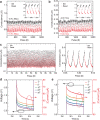Multi-level, forming and filament free, bulk switching trilayer RRAM for neuromorphic computing at the edge
- PMID: 38664381
- PMCID: PMC11045755
- DOI: 10.1038/s41467-024-46682-1
Multi-level, forming and filament free, bulk switching trilayer RRAM for neuromorphic computing at the edge
Abstract
CMOS-RRAM integration holds great promise for low energy and high throughput neuromorphic computing. However, most RRAM technologies relying on filamentary switching suffer from variations and noise, leading to computational accuracy loss, increased energy consumption, and overhead by expensive program and verify schemes. We developed a filament-free, bulk switching RRAM technology to address these challenges. We systematically engineered a trilayer metal-oxide stack and investigated the switching characteristics of RRAM with varying thicknesses and oxygen vacancy distributions to achieve reliable bulk switching without any filament formation. We demonstrated bulk switching at megaohm regime with high current nonlinearity, up to 100 levels without compliance current. We developed a neuromorphic compute-in-memory platform and showcased edge computing by implementing a spiking neural network for an autonomous navigation/racing task. Our work addresses challenges posed by existing RRAM technologies and paves the way for neuromorphic computing at the edge under strict size, weight, and power constraints.
© 2024. The Author(s).
Conflict of interest statement
The authors declare no competing interests.
Figures






References
-
- Jouppi, N. P. et al. In-datacenter performance analysis of a tensor processing unit. In Proceedings of the 44th annual international symposium on computer architecture, 1-12 (Association for Computing Machinery, 2017).
-
- Keckler SW, Dally WJ, Khailany B, Garland M, Glasco D. GPUs and the future of parallel computing. IEEE Micro. 2011;31:7–17. doi: 10.1109/MM.2011.89. - DOI
-
- Oh S, Huang Z, Shi Y, Kuzum D. The impact of resistance drift of phase change memory (PCM) synaptic devices on artificial neural network performance. IEEE Electron Device Lett. 2019;40:1325–1328. doi: 10.1109/LED.2019.2925832. - DOI
-
- Shi Y, et al. Performance prospects of deeply scaled spin-transfer torque magnetic random-access memory for in-memory computing. IEEE Electron Device Lett. 2020;41:1126–1129. doi: 10.1109/LED.2020.2995819. - DOI

